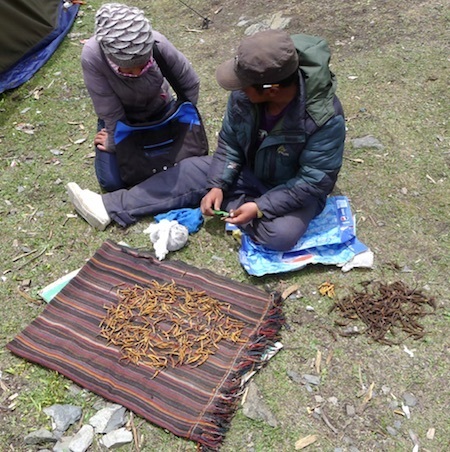Marc Abrahams's Blog, page 365
November 3, 2014
Winds overpower ‘Dance Your Ph.D.’ competition
 This year’s Dance Your Ph.D competition produced a winner: Uma Nagendra (pictured here) of the University of Georgia, USA, for her dance about some effects of winds on plants:
This year’s Dance Your Ph.D competition produced a winner: Uma Nagendra (pictured here) of the University of Georgia, USA, for her dance about some effects of winds on plants:
John Bohannon, who founded and runs the competition, provides details about all the high finishers, in Science magazine. The list of runners-up, with links to each of those videos, appears in that column. This was, I believe, the first year that anyone entered a dance video about mayonnaise. The mayo video, by Saioa Alvarez of the University of the Basque Country, Spain, won in the chemistry category:
I again this year had the delight of being one of the judges. Congratulations to all the entrants, who collectively danced, choreographed, filmed and edited their hearts, lungs, atoms, electrons, and pretty much everything else off, in creating their entries.

The intensifier ‘ass’, in snippets
snippets journal publishes notes that contribute to the study of syntax and  semantics in generative grammar. The notes are brief, self-contained and explicit. For an example of the content, can we recommend a 2011 paper by Professor Daniel Siddiqi (Carlton University, US) who examines the ‘ass’ intensifier.
semantics in generative grammar. The notes are brief, self-contained and explicit. For an example of the content, can we recommend a 2011 paper by Professor Daniel Siddiqi (Carlton University, US) who examines the ‘ass’ intensifier.
“English has recently developed a new intensifier, ass, which means something very close to very, is marked as vulgar and colloquial, and appears in cases such as in (1):
a.That is a big-ass chair
b. It is a cold-ass night
c. It is freezing-ass cold”
“Ass has a restriction that it appear with phonology on either side, suggesting that it is an infix. However, unlike other infixes, ass`s restrictions on its distribution are that it requires syntactic heads (in the same phrase) to be on either side of it. This, of course, seems to be a standard case of tmesis, but tmesis , on a morpho-syntactic level, is typically constrained to compound nouns or morphologically complex words (suggesting morpho-phonemic restriction). This suggests that ass infixation does not seem to be typical tmesis either. This makes the English intensifier ass a curious SYNTACTIC infix, perhaps providing more evidence for a sophisticated morphology-syntax interface.“
See: ‘The English intensifier ass ‘ in: snippets, issue 23, May 2011.
Notes:
• The lower-case ‘s’ in snippets is intentional.
• ‘Tmesis’ is defined (in Webster’s Revised Unabridged Dictionary (1913 + 1828) thus:
Tme”sis (?), n. [L., from Gr. a cutting, fr. to cut.] (Gram.) The separation of the parts of a compound word by the intervention of one or more words; as, in what place soever, for whatsoever place.
Also see: (only loosely, if at all, related) Dr. Gillis’s Kick Butt™ ball.

November 2, 2014
Frozen chicken, wild fish, and fingernails
 Frozen chicken, wild fish, and fingernails all come together in a single, scientific investigation:
Frozen chicken, wild fish, and fingernails all come together in a single, scientific investigation:
“Frozen chicken for wild fish: Nutritional transition in the Brazilian Amazon region determined by carbon and nitrogen stable isotope ratios in fingernails,” Gabriela B. Nardoto, et al., American Journal of Human Biology, Epub May 31, 2011. The authors explain:
“Amazonian populations are experiencing dietary changes characteristic of the nutrition transition. However, the degree of change appears to vary between urban and rural settings. To investigate this process, we determined carbon and nitrogen stable isotope ratios in fingernails and dietary intake of Amazonian populations living along a rural to urban continuum along the Solimões River in Brazil.”

November 1, 2014
A mile of pi, unrolled on an airport landing strip
If you print out the first million digits of the number pi, on a piece of paper a mile (slightly more than a mile, really) long, then unroll the paper, you would see something like what you see in this video made by Brady Haran for NumberPhile:

October 31, 2014
‘WIILTBA’ (bat! rat! rock!) questions – a partial listing
 This month it’s (roughly) the 40th anniversary of the publication of Professor Emeritus Thomas Nagel‘s now-famous philosophical essay entitled : What Is It Like To Be a Bat? ( Philosophical Review, 83, no. 4 )
This month it’s (roughly) the 40th anniversary of the publication of Professor Emeritus Thomas Nagel‘s now-famous philosophical essay entitled : What Is It Like To Be a Bat? ( Philosophical Review, 83, no. 4 )
Since then, a considerable number of other academic writers, researchers and philosophers have paid tribute to professor Nagel’s bat paper (be it intentionally or not) by using similar titles for their compositions. Here are some examples of so-called ‘WIILTBA’ questions: (listed, roughly, according to the number of syllables).
What is it like to be a –
• rat?
• rock?
• bot?
• god?
• quark?
• cell?
• group?
• human?
• person?
• peahen?
• zombie?
• bachelor?
• dualist?
• Chinese room?
• synesthete?
• butterfly?
• geologist?
• generalist?
• school principal?
• musicologist?
• PhD student?
• phenomenologist?
• person who knows nothing?
• deflationary theory of meaning?
• solicitor in commerce and industry?
• special librarian at the center for creative leadership?

The Goodness of the Goal of Being Delightfully Lost
Many museums strive to eliminate all potential for confusing the visitors. That goal may sometimes work against the interest of the visitors and the interests of the museum, suggests this report:
“Delightfully Lost: A New Kind of Wayfinding at Kew,” Natasha Waterson and Mike Saunders, paper presented at the Museums and the Web conference, April 11-14, in San Diego, California.
The authors, at the Royal Botanic Gardens, Kew, UK, explain:
“In October 2010, Kew Gardens commissioned an in-depth study of visitors’ motivations and information needs around its 300-acre site, with the express aim that it should guide the development of new mobile apps. The work involved over 1,500 visitor-tracking observations, 350 mini-interviews, 200 detailed exit interviews, and 85 fulfilment maps; and gave Kew an incredibly useful insight into its visitors’ wants, needs, and resulting behaviours.
“It turns out that most Kew visitors have social, emotional, and spiritual, rather than intellectual, motivations during their time here. They do not come hoping to find out more, and they don’t want or need to know precisely where they are all the time. In fact, they love the sense of unguided exploration and the serendipitous discoveries they make at Kew—they want to become ‘delightfully lost.’
“This paper will explore how this perhaps counterintuitive idea—to help visitors become “delightfully lost”—has influenced mobile thinking at Kew.”
Co-author Watterson produced some videos, of which this is one:
(Thanks to Genevieve Bell for bringing this to our attention.)
BONUS: The Kew Gardens mobile app (the link takes you to the iTunes store)

Halloweenish research, back when
Tonight being Halloween, it’s a good time to look back at some research with a Halloweenish flavor.
Back in the year 2000 — a year whose approach some people pretended to find scary — we published a two part Halloween Research review:
PART !: Werewolves and Vampires, Zombies and Monsters
PART 2: Monsters and Ghouls, Screams and Spooks
And… one must not neglect, unless one must or wants to neglect, The Possible Influence of Halloween on Childbirth.

October 30, 2014
Local Management for Sustainable Agronomic Development of ‘Himalayan Viagra’
In the case of so-called “Himalayan Viagra,” farmers in Tebet are devising their own way to protect a suddenly valuable, scare local crop, suggests this study:
“Indigenous Management Strategies and Socioeconomic Impacts of Yartsa Gunbu (Ophiocordyceps sinensis) Harvesting in Nubri and Tsum, Nepal,” Geoff Childs, Namgyal Choedup, Himalaya, the Journal of the Association for Nepal and Himalayan Studies: Vol. 34: No. 1, Article 7, 2014.
The authors, at Washington University in St. Louis, write:
“Today yartsa gunbu is widely traded as a powerful tonic in Chinese medicine, is often referred to as ‘Himalayan Viagra’ in the media, and has become such an important commodity that scholars nominated it to be China’s national fungus… This paper describes the situation in Nubri and Tsum where yartsa gunbu has been collected by local medical practitioners for centuries, but only became a critical part of people’s household economies within the last decade…. We use Nubri and Tsum as case studies to illustrate how some communities are dealing with a phenomenon that is transforming people’s lives faster than any development scheme could envision.”
BONUS: Richard Conniff, in the Strange Behaviors blog, has some commentary on the matter.
BONUS: An NPR report from 2011: “Caterpillar Fungus: The Viagra Of The Himalayas“. It says, in part: “Britt Bunyard, a professor at the University of Wisconsin and editor of Fungi Magazine, explains that this fungi (Cordyceps Sinensis) makes its living by getting inside a host insect and ultimately killing and consuming it. In this case, the insect that’s invaded is the caterpillar of the ghost moth.”

Assessing the sameness and non-rarity of hipsters
Hipsters are becoming more common, in both major senses of the word common, suggests this study:
“The hipster effect: When anticonformists all look the same,” Jonathan Touboul, arXiv:1410.8001, October 29, 2014.
The author explains:
“In such different domains as statistical physics and spin glasses, neurosciences, social science, economics and finance, large ensemble of interacting individuals taking their decisions either in accordance (mainstream) or against (hipsters) the majority are ubiquitous. Yet, trying hard to be different often ends up in hipsters consistently taking the same decisions, in other words all looking alike. We resolve this apparent paradox studying a canonical model of statistical physics, enriched by incorporating the delays necessary for information to be communicated. We show a generic phase transition in the system: when hipsters are too slow in detecting the trends, they will keep making the same choices and therefore remain correlated as time goes by, while their trend evolves in time as a periodic function. This is true as long as the majority of the population is made of hipsters. Otherwise, hipsters will be, again, largely aligned, towards a constant direction which is imposed by the mainstream choices. Beyond the choice of the best suit to wear this winter, this study may have important implications in understanding dynamics of inhibitory networks of the brain or investment strategies finance, or the understanding of emergent dynamics in social science, domains in which delays of communication and the geometry of the systems are prominent.”
Touboul is, in his own words: Principal Investigator “of the Mathematical Neuroscience Team, part of the Center for Interdisciplinary Research in Biology of the Collège de France. I am researcher at Inria (Paris), in the MYCENAE Team.” He writes, in this paper, in the royal we. He does not explicitly self-identify as a hipster.
(Thanks to investigator Leah Branch for bringing this to our attention).

Swaggering in the performance of root canal procedures
 Swaggering could be of importance when one has to perform a root canal procedure. This patent shows one way to introduce—and guarantee—that swaggering will be part of the fun:
Swaggering could be of importance when one has to perform a root canal procedure. This patent shows one way to introduce—and guarantee—that swaggering will be part of the fun:
“Swaggering endodontic instruments,” US patent 8454361 granted June 4, 2013 to Michael J. Scianamblo [pictured here]. The patent document explains:
“Endodontic instruments are described which have at least a section with a center of mass offset from an axis of rotation so that when the instrument is rotated, the section bends away from the axis of rotation.”
Here’s detail from the patent:


Marc Abrahams's Blog
- Marc Abrahams's profile
- 14 followers




